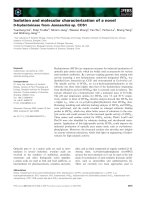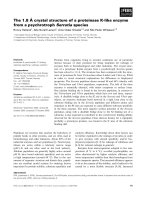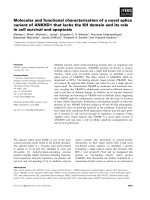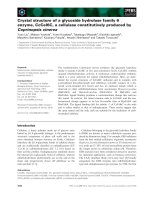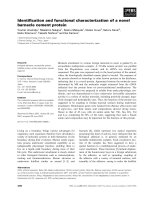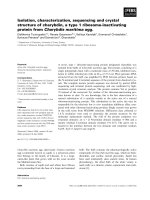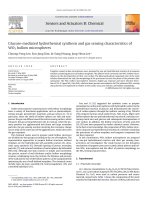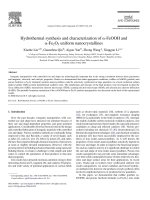- Trang chủ >>
- Khoa Học Tự Nhiên >>
- Vật lý
hydrothermal synthesis and crystal structure of a novel one - dimensional tritungstate
Bạn đang xem bản rút gọn của tài liệu. Xem và tải ngay bản đầy đủ của tài liệu tại đây (245.72 KB, 4 trang )
Ž.
Inorganic Chemistry Communications 3 2000 379–382
www.elsevier.nlrlocaterinoche
Hydrothermal synthesis and crystal structure of a novel one-dimensional
ž/wx
tritungstate: C H N W O
2102 310
Bangbo Yan, Yan Xu
)
, Ngoh K. Goh, Lian S. Chia
DiÕision of Chemistry, School of Science, Nanyang Technological UniÕersity, 469 Bukit Timah Road, Singapore 259756, Singapore
Received 21 February 2000
Abstract
Ž.wx
Ethylenediammonium tritungstate, C H N W O , has been hydrothermally synthesized and structurally characterized. The
2102 310
structure of title compound consists of infinite chains running parallel to the b axis, that are made up of distorted WO octahedra linked
6
through shared corners and edges. The ethylenediammonium ions occupy interstrand region providing space-filling and charge-compensa-
tion to anionic tritungstate matrix. q 2000 Elsevier Science S.A. All rights reserved.
Keywords: Hydrothermal synthesis; Tungstate; Crystal structures; Polyanions compounds
1. Introduction
Recent years have witnessed a considerable achieve-
ment in the crystal engineering of novel organicrinorganic
hybrid materials due to their applications in catalysis,
sorption, energy storage, molecular electronics, optical ma-
wx
terials and ceramics 1–4 . A promising synthetic route
takes advantage of a low-temperature soft approach, hy-
drothermal method, and the structure-directing function of
organoamines. Recent developments in this area have
proven its viability for the successful preparation of novel
wx
porous and low-dimensional materials 5–7 . Typical ex-
amples include coorperative assembly of organic
wx
aminesrtransition metal oxides involving iron 8,9 , cobalt
wx wx w x
10 , vanadium 11 and molybdenum 5,12,13 . While the
combined application of hydrothermal crystallization and
amine templates has been extensively exercised for the
assembly of periodic elements, systematic investigation of
tungsten oxide composite materials remains largely unex-
plored. Here, we report the hydrothermal assembly and
Ž.
crystal structure of a novel one-dimensional tritungstate VI
solid structurally directed and stabilized through ethylene-
Ž.wx
diammonium ions, C H N W O 1.
2102 310
)
Corresponding author. Tel.: q65-460-5179; fax: q65-469-8952.
Ž.
E-mail address: Y. Xu .
2. Experimental
2.1. Synthesis
Ž.
A gel mixture of Na WO P2H O 0.67 g, 2 mmol ,
24 2
Ž.Ž . Ž
ethylenediamine en 0.42 g, 7 mmol and H O 20 ml,
2
.
1.11 mol in the mole ratio 1:3.5:555 was heated at 1908C
and autogenous pressure conditions for 62 h. Needle-shape
Ž.wx
colorless crystals of C H N W O 1 were isolated
2102 310
Ž
and recovered yield: 0.37 g, 48% based on Na WO P
24
. w
2H O . The CHN elemental analysis of 1 gave observed
2
Ž.x Ž. Ž.
calculated in wt% C, 3.02 3.10 ; H, 1.29 1.30 ;N,
Ž.
3.61 3.62 which confirmed an empirical formula of
Ž.wx
C H N W O for 1.
2102 310
2.2. Thermal analysis
Ž.
Thermogravimetric analysis TGA was performed us-
ing a Sateram TG-DTGrDSC thermogravimetric analyzer
on powder specimen of 1 at a heating rate of 58C min
y1
in
N stream.
2
2.3. Infrared studies
IR spectra were recorded using a Perkin–Elmer FT–IR
spectrophotometer on KBr pellets in the range 400–4000
cm
y1
.
1387-7003r00r$ - see front matter q 2000 Elsevier Science S.A. All rights reserved.
Ž.
PII: S1387-7003 00 00085-X
()
B. Yan, et al.rInorganic Chemistry Communications 3 2000 379–382380
Ž.wx
Fig. 1. Packing view of C H N W O 1 along the b-axis.
2102 310
2.4. X-ray Crystallographic Studies
X-ray crystallographic data of 1 were collected on
a Siemens P4 diffractometer. Crystal data: monoclinic
() Ž. Ž. Ž.
P2 1 rn, as8.9512 10 , bs7.6483 11 , cs16.005 3
˚˚
3
Ž. Ž.
A,
b
s92.020 14 8, Vs 1095.0 3 A , D s4.693 g
calc
cm
y3
and Zs4. The structure was solved by direct
methods and refined using full-matrix least squares on F
2
wx
using the SHELXTL-97 package 14 . Non-hydrogen atoms
were refined with anisotropic temperature factors. Hydro-
gen atoms were placed at calculated positions and refined
using the riding model of SHELXTL program with a fixed
˚
C–H bond length of 0.97 A and a N–H bond length of
˚
0.90 A. Final refinement was based on 1917 reflections
w Ž.x Ž.
I)2s I for 134 parameters and converged to RwR
12
Ž.
s0.0281 0.0634 . Atomic coordinates, bond lengths and
angles and thermal parameters are presented in supplemen-
tary crystallographic data.
3. Results and Discussion
The title compound is initially isolated from the hy-
drothermal reaction of WO , en, NaOH and H O in
32
polycrystalline form. Replacement of NaOH with LiOH
produces the same crystalline phase with similar product
quality and morphology. The reaction is then rationalized
by using Na WO as W
6q
source instead of WO that
24 3
gives rise to monophasic product of compound 1 contain-
ing large single crystals. TGA shows a weight loss of ca.
7.9% in the temperature range 300–4808C indicating the
Ž.
release of en molecules calc, 8.0% . The infrared spectra
of 1 present the following information: strong absorption
y1
Ž.
bands at 935 and 975 cm are ascribed to Õ WsO , and
the features in the 784–889 cm
y1
region are most likely
Ž.
associated with Õ O–W–O modes. In addition, absorption
bands at 1480 and 1624 cm
y1
, and a broad band centred at
3400 cm
y1
suggest the presence of en species. By replac-
ing en with other organodiamines such as 2,2
X
-bipyridine
Ž
X
.
2,2 -bipy , piperazine, and 4,4’-bipyridine, a few new
organicrinorganic hybrid phases are obtained and struc-
turally identified using the single crystal X-ray diffraction
method. Brief crystal data of one of the phases, a mono-
4y
Ž.wx
Fig. 2. Structural building block W O of C H N W O 1.
6 20 2 10 2 3 10
()
B. Yan, et al.rInorganic Chemistry Communications 3 2000 379–382 381
Fig. 3. Comparison of the one-dimensional chains adopted by the anions
Ž.Ž .wxŽ.Ž .wxwxŽ.
in: a C H N W O 1; b C H N Mo O 15 ; and c an
2102 310 2102 310
wxwx
open framework solid K W O 16 .
2310
Ž
X
.
clinic one-dimensional solid WO 2,2 -bipy , are summa-
3
rized in a footnote
1
.
Ž.wx
The structure of C H N W O 1 consists of infi-
2102 310
nite puckered chains of W O
4y
separated by interstrand
620
2q
Ž
2q
.
ethylenediammonium ions, C H N enH , as shown
2102 2
in Fig. 1. The W
6q
sites exhibit distorted octahedral
geometry which receive contributions from 1-, 2- and
4-coordinated oxo groups. Each W O
4y
unit consists of a
620
pair of center-of-symmetry-related W O trimers of
310
edge-sharing WO octahedra as shown in Fig. 2. Adjacent
6
WO
4y
units are connected by sharing two corners giving
620
rise to the infinite chain of 1 lying parallel to the b-axis.
Ž.
The coordination geometry of WO at W 1 is defined by
6
two terminal oxo groups and four unsymmetrical bridging
Ž. Ž.
oxo groups, and at W 2 and W 3 by one terminal oxo
Ž.
group and five unsymmetrical bridging oxo groups. W 1
site shows typical two short-two intermediate-two long
Ž. Ž.
bond length pattern of tungsten VI oxides, and W 2 and
Ž.
W 3 show one short-three intermediate-two long bond
length pattern. enH
2q
cations occupy interstrand regions
2
of the W O
4y
chains and exhibit strong hydrogen bond
620
network to terminal and bridging oxo groups of the anionic
chains of W O
4y
.
620
1
Ž
X
.
Crystal data for the monoclinic WO 2,2 -bipy phase. chemical
3
formula, C H N O W, M s 388.03, monoclinic space group Cc with
10 823 w
˚
Ž. Ž. Ž .
unit cell dimensions as14.323 3 , bs9.608 2 , cs7.2922 15 A,
b
s
˚
3 y3
Ž. Ž.
101.980 16 8, Vs981.6 4 A , Zs4, D s2.626 g cm ,
m
s11.759
c
mm
-1
, Ts297 K.
The linkage between WO octahedra in 1 is quite
6
Ž.wxwx
distinct from those reported in C H N Mo O 15
2102 310
ŽŽ
4y
Fig. 3 b . The anionic chain of W O of 1 is con-
620
structed from corner- and edge-sharing WO octahedra
6
while the one-dimensional chains of Mo O
4y
of
620
Ž.wxwx
C H N Mo O 15 is built up from MoO octahedra
2102 310 6
through shared corners, edges and faces. It should be
Ž.wx
further noted that compound C H N W O 1 re-
2102 310
ported in this paper is not analogous to a known tritungstate
wxwx
2y
phase, K W O 16 , in which W O anions are orga-
2310 310
nized into a three dimensional covalent framework struc-
Ž
ture through corner- and edge-shared WO octahedra Fig.
6
Ž
3c .
Ž.wx
The one-dimensional tritungstate C H N W O 1
2102 310
reported in this paper provides novel examples to the
hydrothermal cooperate assembly of tungsten oxide com-
posite materials. The strong solvating effect of water in
combination with the structure-directing role of
organoamines under the hydrothermal autogenous condi-
tions evidently provides the conducive environment for the
rearrangement of tungstenoxoanions, and construction of
novel solid architecture from molecular precursors. It opens
up the possibility of applying this method for assembling
other low-dimensional and open-framework tungsten oxide
materials with potentially interesting or useful properties.
4. Conclusion
Ž.
The successful synthesis of compound C H N
2102
wx
WO 1 illustrates the power of hydrothermal synthesis
310
in engineering organicrinorganic solid materials with novel
structures. It should be further noted that organic cations
play a significant role in the isolation of the tritungstate
phases. Furthermore, the structure differences between
Ž.wx
CH N WO 1 and open-framework potassium
2102 310
Ž.wx
tritungstate, and that between C H N W O 1 and
2102 310
ethylenediammonium trimolybdate solids suggests that it
would be worth exploring the hydrothermal chemistry of
organicrtungsten oxide hybrid materials.
References
wx Ž.
1 A.K. Cheetham, Science 264 1994 794, and references therein.
wx
2 P.A. Cox, Transition Metal Oxides, Clarendon Press, Oxford, 1995.
wx
3 C.T. Kresge, M.Z. Leonwicz, W.J. Roth, J.C. Vatuli, J.C. Beck,
Ž.
Nature 359 1992 710.
wx
4 Q.S. Huo, D.I. Margolene, U. Ciesla, P.Y. Peng, T.E. Gier, P.
Sieger, R. Leon, P.M. Petroff, F. Schuth, G.D. Stucky, Nature 368
Ž.
1994 317.
wx Ž.
5 R.C. Haushalter, L.A. Mundi, Chem. Mater. 4 1992 31.
wx
6 R.L. Bedard, S.T. Wilson, L.D. Vail, J.M. Bennett, E.M. Flanigen,
in: Zeolites: Facts, Figures, Future, Elsevier, Amsterdam, 1989, p.
375.
wx
7 A. Merrouche, J. Patarin, H. Kessler, M. Soulard, L. Delmotte, J.L.
Ž.
Guth, F. Joly, Zeolites 12 1992 226.
()
B. Yan, et al.rInorganic Chemistry Communications 3 2000 379–382382
wx
8 M. Cavellec, D. Rio, C. Ninclaus, J.M. Greneche, G. Ferey, Zeolites
`´
Ž.
17 1996 260.
wx
9 K.H. Lii, Y.F. Huang, V. Zima, C.Y. Huang, H.M. Lin, Y.C. Jiang,
Ž.
F.L. Liao, S.L. Wang, Chem. Mater. 25 1998 2599, and references
therein.
wx
10 J. Chen, R.H. Jones, S. Natarajan, M.B. Hursthouse, J.M. Thomas,
Ž.
Angew. Chem. Int. Ed. Engl. 33 1994 639.
wx
11 T. Chirayil, P.Y. Zavalij, M.S. Whittingham, Chem. Mater. 10
Ž.
1998 2629.
wx
12 P.J. Hagrman, D. Hagrman, J. Zubieta, Angew. Chem. Int. Ed. Engl.
Ž.
38 1999 2638.
wx Ž.
13 J.J. Lu, Y. Xu, N.K. Goh, and L.S. Chia, Chem. Commun. 1998
1709.
wx
14 G.M. Sheldrick,
SHELXTL
PC, Version 97, Siemens Analytical Instru-
ments, Madison, WI, 1994.
wx Ž.
15 M.I. Khan, Q. Chen, J. Zubieta, Inorg. Chim. Acta 213 1993 325.
wx
16 K. Okada, H. Morikawa, F. Marumo, S. Iwai, Acta Crystallogr. B32
Ž.
1976 1522.
